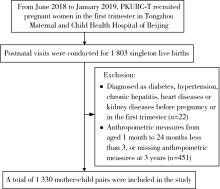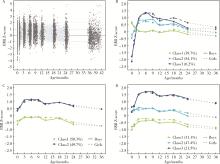Journal of Peking University (Health Sciences) ›› 2024, Vol. 56 ›› Issue (3): 390-396. doi: 10.19723/j.issn.1671-167X.2024.03.003
Previous Articles Next Articles
A prospective cohort study of association between early childhood body mass index trajectories and the risk of overweight
Zhihan YUE1,Na HAN2,Zheng BAO2,Jinlang LYU1,Tianyi ZHOU1,Yuelong JI1,Hui WANG1,Jue LIU3,Haijun WANG1,*( )
)
- 1. Department of Maternal and Child Health, Peking University School of Public Health, Beijing 100191, China
2. Tongzhou Maternal and Child Health Hospital of Beijing, Beijing 101101, China
3. Department of Epidemiology and Biostatistics, Peking University School of Public Health, Beijing 100191, China
CLC Number:
- R179
| 1 |
Barker DJ . The fetal and infant origins of adult disease[J]. BMJ, 1990, 301 (6761): 1111.
doi: 10.1136/bmj.301.6761.1111 |
| 2 |
Geserick M , Vogel M , Gausche R , et al. Acceleration of BMI in early childhood and risk of sustained obesity[J]. N Engl J Med, 2018, 379 (14): 1303- 1312.
doi: 10.1056/NEJMoa1803527 |
| 3 |
Yuan Y , Chu C , Zheng WL , et al. Body mass index trajectories in early life is predictive of cardiometabolic risk[J]. J Pediatr, 2020, 219, 31-37, e36.
doi: 10.1016/j.jpeds.2019.12.060 |
| 4 | Aris IM , Bernard JY , Chen LW , et al. Infant body mass index peak and early childhood cardio-metabolic risk markers in a multi-ethnic Asian birth cohort[J]. Int J Epidemiol, 2017, 46 (2): 513- 525. |
| 5 |
den Dekker HT , Jaddoe VWV , Reiss IK , et al. Fetal and infant growth patterns and risk of lower lung function and asthma. The generation R study[J]. Am J Respir Crit Care Med, 2018, 197 (2): 183- 192.
doi: 10.1164/rccm.201703-0631OC |
| 6 |
Mattsson M , Maher GM , Boland F , et al. Group-based trajectory modelling for BMI trajectories in childhood: A systematic review[J]. Obes Rev, 2019, 20 (7): 998- 1015.
doi: 10.1111/obr.12842 |
| 7 |
Cao T , Zhao J , Hong X , et al. Cord blood metabolome and BMI trajectory from birth to adolescence: A prospective birth cohort study on early life biomarkers of persistent obesity[J]. Metabolites, 2021, 11 (11): 739.
doi: 10.3390/metabo11110739 |
| 8 |
Meir AY , Huang W , Cao T , et al. Umbilical cord DNA methylation is associated with body mass index trajectories from birth to adolescence[J]. EBioMedicine, 2023, 91, 104550.
doi: 10.1016/j.ebiom.2023.104550 |
| 9 |
Jin C , Lin L , Han N , et al. Effects of dynamic change in fetuin-A levels from the first to the second trimester on insulin resistance and gestational diabetes mellitus: A nested case-control study[J]. BMJ Open Diabetes Res Care, 2020, 8 (1): e000802.
doi: 10.1136/bmjdrc-2019-000802 |
| 10 | World Health Organization. WHO child growth standards: Length/height-for-age, weight-for-age, weight-for-length, weight-for-height and body mass index-for-age: Methods and development [R]. Geneva: World Health Organization, 2006. |
| 11 |
de Onis M , Lobstein T . Defining obesity risk status in the general childhood population: Which cut-offs should we use[J]. Int J Pediatr Obes, 2010, 5 (6): 458- 460.
doi: 10.3109/17477161003615583 |
| 12 | World Health Organization, the United Nations Children' s Fund (UNICEF). Indicators for assessing infant and young child feeding practices: Definitions and measurement methods [R]. Geneva: World Health Organization and the United Nations Children' s Fund (UNICEF), 2021. |
| 13 | 房玥晖, 何宇纳, 李春丽. 基于中国学龄前儿童平衡膳食指数的2010—2012年中国学龄前儿童膳食质量评价[J]. 中华预防医学杂志, 2020, 54 (6): 662- 667. |
| 14 |
Wen LM , van der Ploeg HP , Kite J , et al. A validation study of assessing physical activity and sedentary behavior in children aged 3 to 5 years[J]. Pediatr Exerc Sci, 2010, 22 (3): 408- 420.
doi: 10.1123/pes.22.3.408 |
| 15 | Proust-Lima C , Philipps V , Liquet B . Estimation of extended mixed models using latent classes and latent processes: The R package lcmm[J]. J Stat Softw, 2017, 78 (2): 1- 56. |
| 16 | Genolini C , Alacoque X , Sentenac M , et al. kml and kml3d: R packages to cluster longitudinal data[J]. J Stat Softw, 2015, 65 (4): 1- 34. |
| 17 |
Stekhoven DJ , Bühlmann P . MissForest: Non-parametric missing value imputation for mixed-type data[J]. Bioinformatics, 2012, 28 (1): 112- 118.
doi: 10.1093/bioinformatics/btr597 |
| 18 |
Hu Z , Tylavsky FA , Han JC , et al. Maternal metabolic factors during pregnancy predict early childhood growth trajectories and obesity risk: The CANDLE study[J]. Int J Obes (Lond), 2019, 43 (10): 1914- 1922.
doi: 10.1038/s41366-019-0326-z |
| 19 |
Montazeri P , Vrijheid M , Martinez D , et al. Maternal metabolic health parameters during pregnancy in relation to early childhood BMI trajectories[J]. Obesity (Silver Spring), 2018, 26 (3): 588- 596.
doi: 10.1002/oby.22095 |
| 20 |
Michael N , Gupta V , Fogel A , et al. Longitudinal characterization of determinants associated with obesogenic growth patterns in early childhood[J]. Int J Epidemiol, 2023, 52 (2): 426- 439.
doi: 10.1093/ije/dyac177 |
| 21 | 李春刚, 严双琴, 高国朋, 等. 母亲孕期饮食模式与儿童早期BMI变化轨迹关联的队列研究[J]. 中华流行病学杂志, 2023, 44 (11): 1769- 1775. |
| 22 | Xiong C , Chen K , Xu LL , et al. Associations of prenatal exposure to bisphenols with BMI growth trajectories in offspring within the first two years: Evidence from a birth cohort study in China[J]. World J Pediatr, 2023, 2023-11-29 (2024-02-01) |
| 23 | Nguena Nguefack HL , Pagé MG , Katz J , et al. Trajectory modelling techniques useful to epidemiological research: A comparative narrative review of approaches[J]. Clin Epidemiol, 2020, 12, 1205- 1222. |
| 24 | Den Teuling NGP , Pauws SC , van den Heuvel ER . A comparison of methods for clustering longitudinal data with slowly changing trends[J]. Commun Stat Simul Comput, 2023, 52 (3): 621- 648. |
| 25 | Huang W , Meir AY , Olapeju B , et al. Defining longitudinal trajectory of body mass index percentile and predicting childhood obesity: Methodologies and findings in the Boston birth cohort[J]. Precis Nutr, 2023, 2 (2): e00037. |
| [1] | Jing CHEN,Rui SHAN,Wucai XIAO,Xiaorui ZHANG,Zheng LIU. Association between self-control and co-occurrence of depressive symptoms and overweight or obesity during adolescence and early adulthood: A ten-year prospective cohort study based on national surveys [J]. Journal of Peking University (Health Sciences), 2024, 56(3): 397-402. |
| [2] | Yifan WU,Yingxiang YU,Lan XIE,Zhida ZHANG,Cuiqing CHANG. Characteristics of resting energy expenditure and evaluation of prediction formulas in young men with different body mass indexes [J]. Journal of Peking University (Health Sciences), 2024, 56(2): 247-252. |
| [3] | Jia-jia DANG,Shan CAI,Pan-liang ZHONG,Ya-qi WANG,Yun-fei LIU,Di SHI,Zi-yue CHEN,Yi-hang ZHANG,Pei-jin HU,Jing LI,Jun MA,Yi SONG. Association of outdoor artificial light at night exposure with overweight and obesity among children and adolescents aged 9 to 18 years in China [J]. Journal of Peking University (Health Sciences), 2023, 55(3): 421-428. |
| [4] | LIU Jie,GUO Chao. A prospective cohort study of the influence of positive/negative effectivity on the mortality risk of the Chinese elderly [J]. Journal of Peking University (Health Sciences), 2022, 54(2): 255-260. |
| [5] | DONG Yan-hui, SONG Yi, DONG Bin, ZOU Zhi-yong, WANG Zheng-he, YANG Zhao-geng, WANG Xi-jie, LI Yan-hui, MA Jun. Association between the blood pressure status and nutritional status among Chinese students aged 7-18 years in 2014: based on the national blood pressure reference for Chinese children and adolescents [J]. Journal of Peking University(Health Sciences), 2018, 50(3): 422-428. |
| [6] | CHENG Lan, LI Qin, SONG Yi, MA Jun, WANG Hai-Jun. Association of physical activities, sedentary behaviors with overweight/obesity in 9-11 year-old Chinese primary school students [J]. Journal of Peking University(Health Sciences), 2016, 48(3): 436-441. |
| [7] | XIE Gao-Qiang-1△, YU Hui-2, CHEN Jing-Zhou-2, ZHAO Lian-Cheng-3△, REN Fu-Xiu-4, SHI Ping-4, WU Yang-Feng-1, 5 , 6 . Relationship of genetic variants and cardiovascular risk factors with interleukin-6 and interleukin-10 secreted by monocytes [J]. Journal of Peking University(Health Sciences), 2014, 46(4): 589-595. |
|
||



